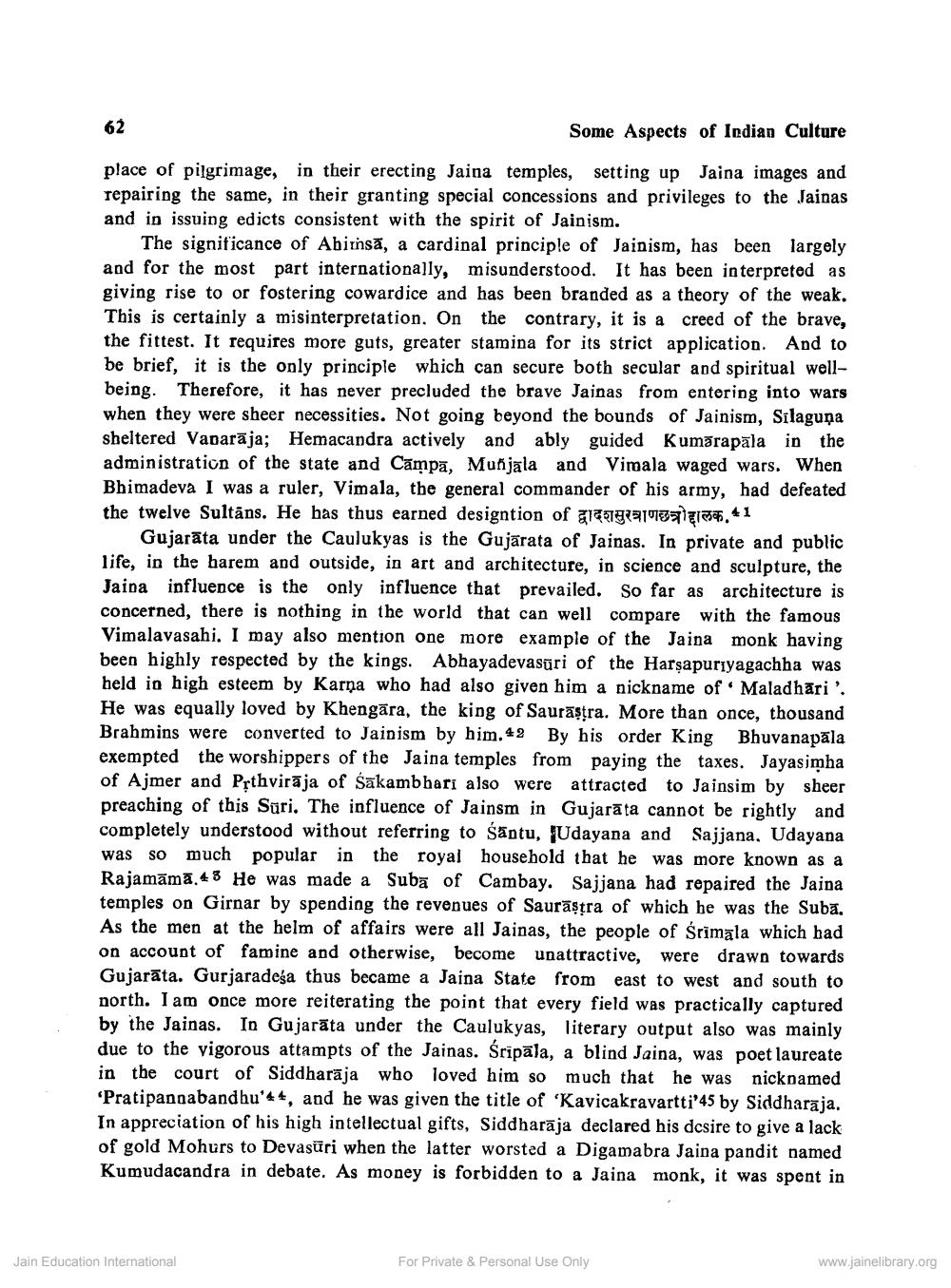________________
62
Some Aspects of Indian Culture place of pilgrimage, in their erecting Jaina temples, setting up Jaina images and repairing the same, in their granting special concessions and privileges to the Jainas and in issuing edicts consistent with the spirit of Jainism.
The significance of Abithsă, a cardinal principle of Jainism, has been largely and for the most part internationally, misunderstood. It has been interpreted as giving rise to or fostering cowardice and has been branded as a theory of the weak. This is certainly a misinterpretation. On the contrary, it is a contrary, it is a creed of the brave, the fittest. It requires more guts, greater stamina for its strict application. And to be brief, it is the only principle which can secure both secular and spiritual wellbeing. Therefore, it has never precluded the brave Jainas from entering into wars when they were sheer necessities. Not going beyond the bounds of Jainism, Silaguna sheltered Vanaraja; Hemacandra actively and ably guided Kumarapala in the administration of the state and Campa, Muñjala and Vimala waged wars. When Bhimadeva I was a ruler, Vimala, the general commander of his army, had defeated the twelve Sultans. He has thus earned designtion of Y04, 41
Gujarata under the Caulukyas is the Gujarata of Jainas. In private and public life, in the harem and outside, in art and architecture, in science and sculpture, the Jaina influence is the only influence that prevailed. So far as architecture is concerned, there is nothing in the world that can well compare with the famous Vimalavasahi. I may also mention one more example of the Jaina monk having been highly respected by the kings. Abhayadevasuri of the Harsapuriyagachha was held in high esteem by Karna who had also given him a nickname of Maladhari. He was equally loved by Khengara, the king of Saurastra. More than once, thousand Brahmins were converted to Jainism by him. 42 By his order King Bhuvanapala exempted the worshippers of the Jaina temples from paying the taxes. Jayasimha of Ajmer and Pṛthviraja of Sakambhari also were attracted to Jainsim by sheer preaching of this Sari. The influence of Jainsm in Gujarata cannot be rightly and completely understood without referring to Santu, Udayana and Sajjana. Udayana was so much popular in the royal household that he was more known as a Rajamäma. He was made a Suba of Cambay. Sajjana had repaired the Jaina temples on Girnar by spending the revenues of Saurastra of which he was the Suba. As the men at the helm of affairs were all Jainas, the people of Śrimala which had on account of famine and otherwise, become unattractive, were drawn towards Gujarata. Gurjaradeja thus became a Jaina State from east to west and south to north. I am once more reiterating the point that every field was practically captured by the Jainas. In Gujarata under the Caulukyas, literary output also was mainly due to the vigorous attampts of the Jainas. Śripala, a blind Jaina, was poet laureate in the court of Siddharaja who loved him so much that he was nicknamed 'Pratipannabandhu', and he was given the title of 'Kavicakravartti'45 by Siddharaja. In appreciation of his high intellectual gifts, Siddharaja declared his desire to give a lack of gold Mohurs to Devasüri when the latter worsted a Digamabra Jaina pandit named Kumudacandra in debate. As money is forbidden to a Jaina monk, it was spent in
Jain Education International
For Private & Personal Use Only
www.jainelibrary.org




